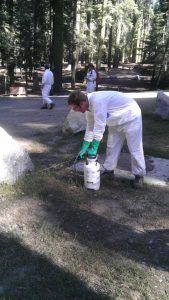Unintended Consequences Of Insecticides
“Unintended consequences” – those situations where we try to create good and the outcome is worse. Recently, my cat required a visit to the vet and, after tests, cultures, repeated visits, and antibiotic injections, the diagnosis was an infection secondary to flea bites. FLEAS??? We’ve NEVER had fleas!!
The recommendation is once-a-month flea treatment. Fipronil, the active ingredient in Frontline and other flea protection products, is a broad-spectrum insecticide in the phenylpyrazole family. It targets a specific central nervous system access channel in insects that does not exist in mammals. Fipronil is used by pest applicators in a formulation known as Termidor to treat ants, cockroaches, termites and FLEAS.
However, according to the California Department of Pesticide Regulation, the application of fipronil applied by licensed pest applicators increased from 300 kg in 2003 to 28,785 kg in 2011. According to sampling done by University of California researchers (https://pubs.acs.org/doi/pdf/10.1021/bk-2014-1168.ch001), fipronil could be found in almost all samples of urban water runoff in Southern California and Sacramento.
The University of California Integrated Pest Management program here, lists fipronil as HIGHLY TOXIC to bees and HIGHLY TOXIC to aquatic wildlife. Concerns over environmental impacts from fipronil surface water contamination have resulted in new labels for the pesticide. Applications are now prohibited between November 1st and February 28th during California’s rainy season.
Vectra, a flea treatment for dogs, lists dinotefuran, a neonicotinoid (“neo-nic”) insecticide that has been implicated in bee colony collapse disorder. Permethrin, the largest ingredient by percentage, is a synthetic insecticide that is highly toxic to fish, other aquatic creatures and bees. In addition, the active ingredients in Vectra are so poisonous to cats that a cat should not be allowed around a dog treated with Vectra until the treatment has dried for 24 hours!
These pesticides are easy to use. Just put a few drops on your pet’s back and throw the applicator tube in the trash. The unintended consequence of our love affair with easy solutions is the inadvertent contamination of our surface waters, the disappearance of bees and the poisoning of water-dwelling animals and insects.
Integrated pest management (http://ipm.ucanr.edu/index.html) is the practice of using the least-invasive and least-poisonous method of pest control possible. In our house, consistent vacuuming, weekly laundering of pet bedding (hot water/hot drier) and a weekly cat rubdown with a dilute vinegar solution did the trick.
Rebecca Miller-Cripps is a University of California Cooperative Extension Master Gardener of Tuolumne County who has decided to treat for pests in non-toxic ways.
UCCE Master Gardeners of Tuolumne and Calaveras Counties can answer home gardening questions. Call 209-533-5912 or go to: http://ucanr.edu/survey/survey.cfm?surveynumber=7269 to fill out our easy-to-use problem questionnaire. Check out our website at: http://cecentralsierra.ucanr.edu/Master_Gardeners/ You can also find us on Facebook at https://www.facebook.com/MasterGardenersTuolCo/

